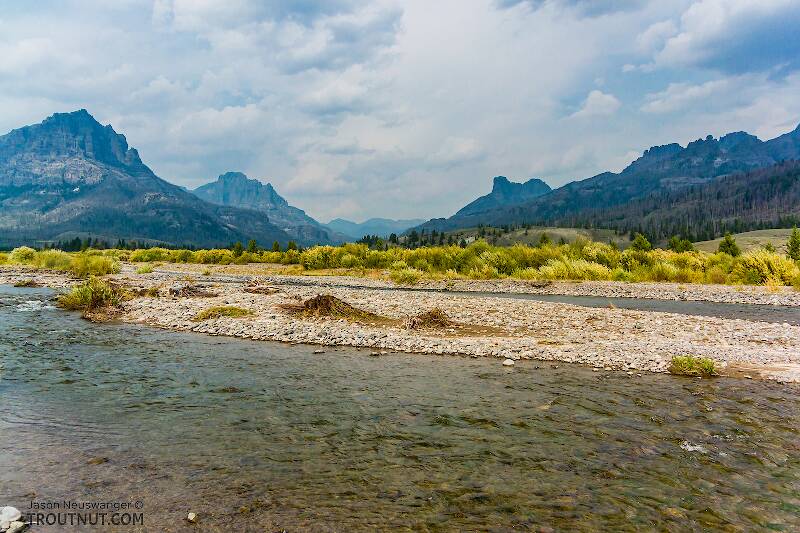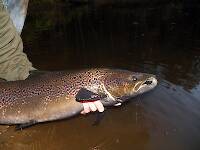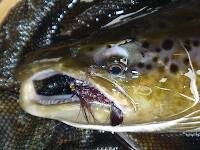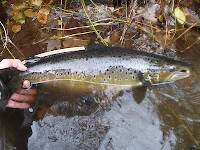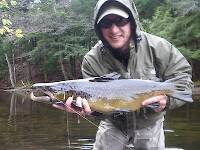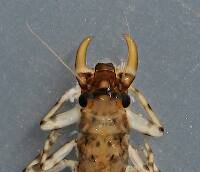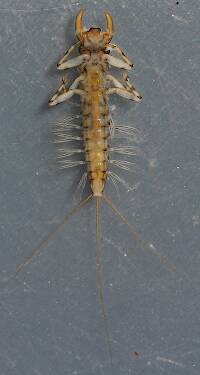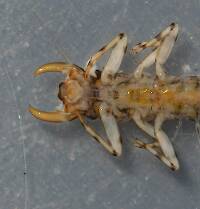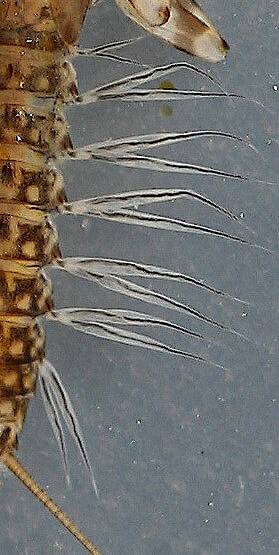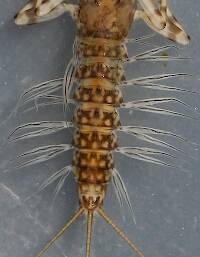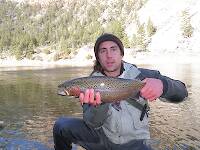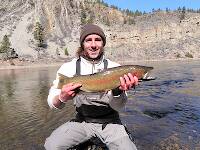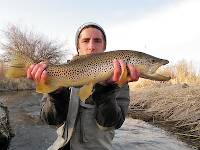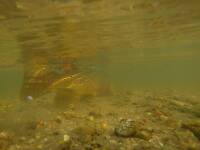
Salmonflies
Pteronarcys californica
The giant Salmonflies of the Western mountains are legendary for their proclivity to elicit consistent dry-fly action and ferocious strikes.
Featured on the forum

With a bit of help from the microscope, this specimen keys clearly and unsurprisingly to Hydropsyche.

Troutnut is a project started in 2003 by salmonid ecologist Jason "Troutnut" Neuswanger to help anglers and
fly tyers unabashedly embrace the entomological side of the sport. Learn more about Troutnut or
support the project for an enhanced experience here.
Ike on Sep 14, 2013September 14th, 2013, 8:05 am EDT
Greetings fellow anglers!
My name is Isaac Ness and I'm starting a research paper on brown trout coloration. In doing so I hope to discover the causes of color variation in the beautiful brown but at the moment I've reached a bit of a wall. While many people have written about what they believed causes color variation, (camouflage, strain or fish, food, etc), there has been little scientific research done to solve the mystery once and for all. As a result I'm requesting help from anglers, and fly fishing experts from the U.S. and abroad . I need pictures of different brown trout showing the colors of the fish and a little information about the condition it was caught in. i.e. what the fish was caught on, a picture or description of the habitat, water temp, where its lie was, tint of water, coloration of the river bottom, what time of year it was caught during, etc. basically any information you can give me about the fish. Even just a picture of the fish would be helpful though. you can email me directly at ness.isaac@gmail.com Thank you for your time and I look forward to potentially working with you!
tight lines! -Isaac Ness
My name is Isaac Ness and I'm starting a research paper on brown trout coloration. In doing so I hope to discover the causes of color variation in the beautiful brown but at the moment I've reached a bit of a wall. While many people have written about what they believed causes color variation, (camouflage, strain or fish, food, etc), there has been little scientific research done to solve the mystery once and for all. As a result I'm requesting help from anglers, and fly fishing experts from the U.S. and abroad . I need pictures of different brown trout showing the colors of the fish and a little information about the condition it was caught in. i.e. what the fish was caught on, a picture or description of the habitat, water temp, where its lie was, tint of water, coloration of the river bottom, what time of year it was caught during, etc. basically any information you can give me about the fish. Even just a picture of the fish would be helpful though. you can email me directly at ness.isaac@gmail.com Thank you for your time and I look forward to potentially working with you!
tight lines! -Isaac Ness
Entoman on Sep 14, 2013September 14th, 2013, 10:46 am EDT
Hi Isaac,
Welcome to the forum! Anybody with that name should be welcome on any angling site. :)
The different look between strains as well as individuals has been studied quite extensively. The balance of influences between nature (genetics), nurture (ecology), and variability are what's at work. It is my understanding that attempts at a deeper understanding of the interrelationship of these factors is at the heart of developing evolutionary theory. I think much can be gleaned for your project by mining the many papers on this topic. I'd start with Dr. Robert Behnke.
Welcome to the forum! Anybody with that name should be welcome on any angling site. :)
The different look between strains as well as individuals has been studied quite extensively. The balance of influences between nature (genetics), nurture (ecology), and variability are what's at work. It is my understanding that attempts at a deeper understanding of the interrelationship of these factors is at the heart of developing evolutionary theory. I think much can be gleaned for your project by mining the many papers on this topic. I'd start with Dr. Robert Behnke.
"It's not that I find fishing so important, it's just that I find all other endeavors of Man equally unimportant... And not nearly as much fun!" Robert Traver, Anatomy of a Fisherman
Wbranch on Sep 16, 2013September 16th, 2013, 5:21 pm EDT
Hello Isaac,
Welcome to the forum, I have dozens of large brown trout pictures and many of them show remarkable color variations even though most were caught in the same river. I'll be sending some pictures to your email shortly.
Matt aka Wbranch
Welcome to the forum, I have dozens of large brown trout pictures and many of them show remarkable color variations even though most were caught in the same river. I'll be sending some pictures to your email shortly.
Matt aka Wbranch
Catskill fly fisher for fifty-five years.
Sayfu
Posts: 560
Posts: 560
Sayfu on Sep 19, 2013September 19th, 2013, 9:43 am EDT
A good portion for your paper regarding Brown Trout could be the DNA difference, IF there is any between anadromous Brown Trout, and Atlantic Salmon. They both inhabit the same saltwater regions, run the same rivers, and when an Atlantic nears spawning in the river, I defy anyone to physically tell the difference. IMO it has become a marketing effort to attract customers to experience the thrill of catching an Atlantic Salmon, and can be an attraction as well to capture a sea-run Brown. Often an angler will identify his Atlantic Salmon prize catch to be too big to be a Brown Trout. I do not think that is an accurate assessment.
Quick Reply
Related Discussions
Topic
Replies
Last Reply
2
Jul 2, 2009
by DayTripper
by DayTripper

